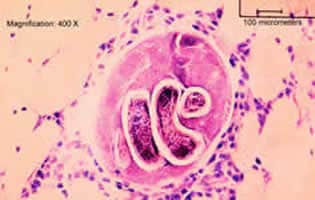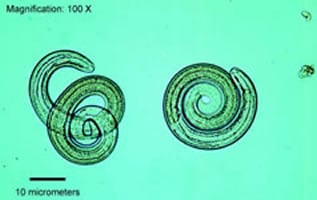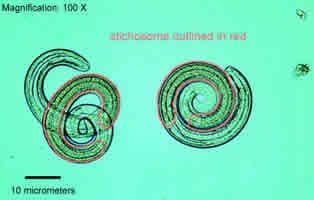
Monthy Case Studies - 2000
Case #38 - June, 2000
A 45-year-old man was admitted to an Ohio emergency room for headache, fever, general muscle aches, and weakness. Laboratory work-up on his blood specimen revealed significantly elevated eosinophilia. The patient reported that he had gone on a camping and hunting trip the month before in Ontario, Canada. He shot and killed a black bear and brought several pounds of meat home. In the weeks before onset of symptoms, he ate several meals that included bear meat. Figure A shows what was seen in a stained section of muscle biopsy taken from the deltoid area of his left arm. Portions of the remaining bear meat were sent to CDC for examination. No parasites were found in compression smears from the bear meat (muscle). A 100 g portion of meat was ground and digested in an acidic pepsin solution. Examination of the sediment revealed small numbers of the objects shown in Figure B. What is your diagnosis? Based on what criteria?

Figure A

Figure B
Answer to Case #38
This was a case of trichinellosis caused by Trichinella spiralis (sensu lato). The presence of small nematode larvae encapsulated in striated muscle is characteristic of infection with this nematode. Examination of a wet tissue compression smear will sometimes reveal coiled larvae. However, if the number of larvae present is small, digestion of a larger sample of meat using artificial gastric juice is necessary. Diagnostic features observed were:
- the size (0.8 to 1.0 mm).
- presence of a blunt tail.
- characteristic stichosome that is composed of the esophagus surrounded by individual stichocytes (Figure B).

Figure B
In the United States and other countries, control of trichinellosis has been achieved because of a combination of factors, including a decrease in the prevalence of infection in market hogs. However, wild animals continue to harbor infections and serve as a source of human infection when meat products are poorly cooked. In the United States, the most recent cases have been from ingestion of bear meat, although cougars have also been implicated. Salting, smoking, and drying of meat are not effective at killing the larvae of Trichinella sp. Some strains from the Nearctic are highly resistant to freezing, as part of the parasites' adaption to survival.
Note: What was once considered a single species, Trichinella spiralis, is now thought to consist of at least five different species (T. spiralis, T. pseudospiralis, T. nativa, T. nelsoni, and T. britova) each with a slightly different geographical distribution and normal range of hosts. All are potentially infective to humans and T. pseudospiralis is the most distinct in that it does not, in the larval stage, typically induce a marked host capsule around the larvae.
More on: Trichinellosis
Images presented in the monthly case studies are from specimens submitted for diagnosis or archiving. On rare occasions, clinical histories given may be partly fictitious.
 ShareCompartir
ShareCompartir


